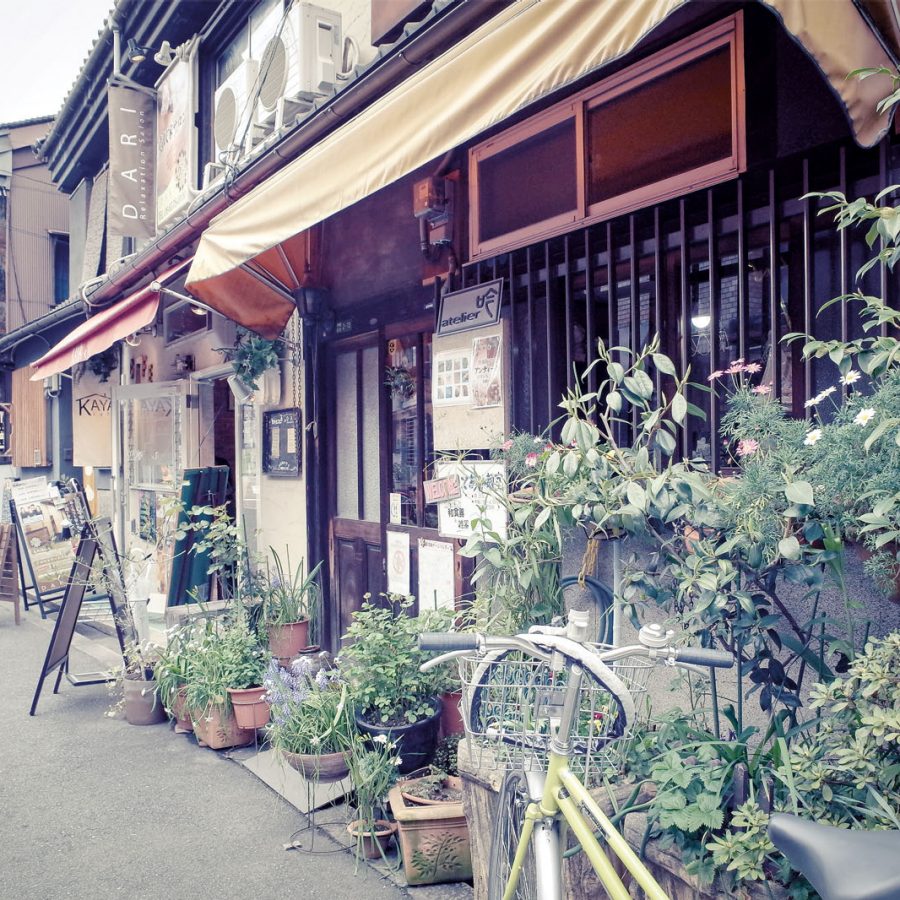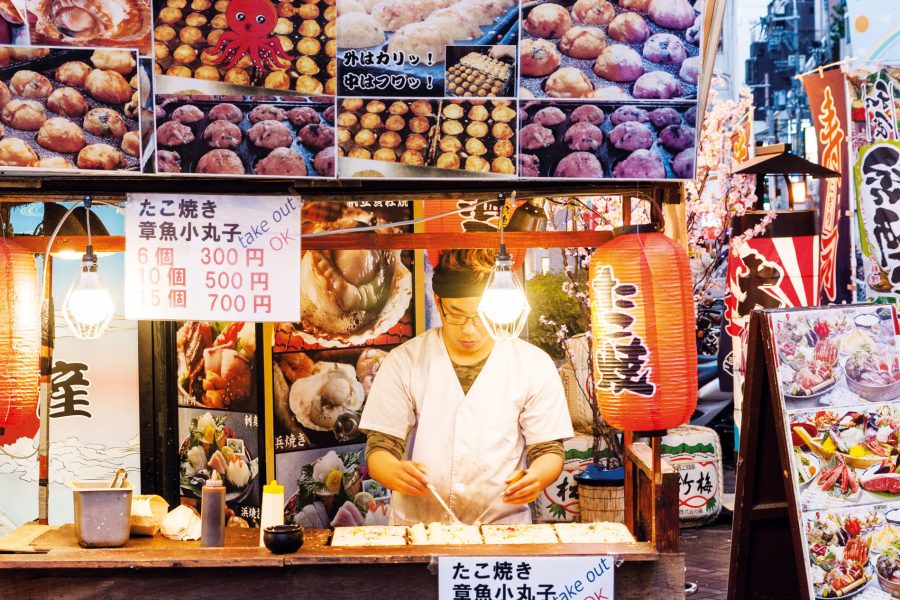Osaka is Japan’s second city and the lively hub of the Kansai region. With celebrations like the Toka Ebisu festival in January and the Nipponbashi Street Festa cosplay event in March, and year-round attractions like the regional food, famously chatty locals and neon-lit nights – not to mention close proximity to traditional counterpoints like Kyoto, Nara and Mount Koya – it’s a trip you won’t forget. The ‘nation’s kitchen’, as Osaka is sometimes called, is always tasty too – whether you opt for a seasonal kaiseki feast, local craft beer or head into the countryside to go strawberry picking.
If you’re wondering exactly what to do in Osaka, here’s a selection of the very best experiences in Osaka and the surrounding Kansai region to add to your itinerary.

Credit: annhfhung / Moment RM / Getty Images
The neighbourhood: Nakazakicho
The old houses of Nakazakicho, a short walk from busy Umeda, have become a haven for small cafes (89 Cafe, where you can also rent a kimono), retro clothing stores (Green Pepe ), craft shops (Guignol and Jam Pot ) and tiny galleries like eclectic Irorimura. It’s so hip, it even has a muesli bar: Granda Familio . Just don’t get there before noon, as many of the shops will still be closed.
The festival: Toka Ebisu
Osaka doesn’t do downtime and the standout festival early in the year is Toka Ebisu (9-11 January), which includes a parade of geisha and local celebrities on the middle day. Or on 14 January, watch out for the Doya Doya (easy to spot as many young men will be running around in loincloths). And for a different event entirely, try the Nipponbashi Street Festa in mid-March – Japan’s largest cosplay event.
The museum: The Cup Noodle Museum
This ode to the instant noodle offers one of the more unusual hands-on experiences you’ll find in Japan. For ¥400 (HK$30) you can create your own instant noodles, including package design, from a potential 5,460 flavour combinations. The Cup Noodles Museum ’s Instant Ramen tunnel is also one of Osaka’s most Instagramable sites.
The market: Shitenno-ji
Founded in 593 AD, Osaka’s Shitenno-ji temple is about as venerable as they get in Japan, but that doesn’t mean a visit has to be hushed and dull. On the 21st of each month, the temple’s flea market is ideal for picking up antiques, used kimono, local crafts and all sorts of bric-a-brac.

Credit: Drazen / iStock by Getty Images
The instagram spot: Dotonbori
The neon lights of Dotonbori – in particular, the Glico Man sign – are an iconic Osaka sight. Most people snap Glico Man from the opposite side of the canal, but you can get a different perspective from the water with a 20-minute Tombori river cruise .
The snack: Kushi Katsu
Once you’ve snarfed popular street snacks like okonomiyaki and takoyaki, find the less heralded (but just as moreish) kushikatsu: skewers of meat, seafood or vegetables, coated in breadcrumbs before being deep-fried and dipped in a thick, sticky, tangy sauce. Tengu (3 Chome-4-12 Ebisuhigashi, Naniwa Ward, Osaka), next to Spa World in Shinsekai, has a friendly Osaka vibe; but there are loads more in the neighbourhood.
The shop: Daiso
Three-floor Daiso in Shinsaibashi, where everything is ¥100 (HK$7) – well, ¥108 (HK$7.5) when you add the tax – is one of the cheapest places to pick up a souvenir: like tabi socks, green tea-flavoured snacks and all sorts of other items that range from basic cosmetics to cute character goods.

The day trip: Nara
One popular option around Osaka is to escape the city for a day trip. Both Kyoto and Himeji Castle are great day trips from Osaka. You can go even further back in time with Nara, Japan’s ancient capital in the eighth century. Even spending just a few hours around the verdant Nara Park area is worth the 50-minute train ride. Don’t miss Todai-ji temple and its giant Buddha statue, or Kasuga-taisha shrine and its hundreds of stone and bronze lanterns.
The cocktail: Takoyaki in the Sky
Takoyaki is the classic Osakan street food. It gets remixed at 40 Sky Bar & Lounge , atop the Conrad Osaka: the Takoyaki in the Sky cocktail balances a takoyaki ball on top of a gin and blue curacao drink.
The view: JR Station City
High above Osaka’s main railway station is a small urban farm. Climb up to the 14th floor of the North Tower of JR Station City (access is from the 11th floor) to find a hidden garden filled with cucumbers, tomatoes and blueberries. Added bonus: from this green rooftop are eye-popping views over western Osaka – the robot-like Umeda Sky Building i s straight ahead – which is particularly alluring at sunset.

Credit: AlxeyPnferov / iStock by Getty Images
The restaurant: Kita Zuien
Think of Osakan food and you picture takoyaki (battered octopus balls), okonomiyaki (savoury pancake) and other sauce-smothered comfort food. But Osaka also does fine dining. With a focus on in-season produce, which depending on the course might include a delicate matsutake soup, freshly caught abalone or chargrilled wagyu, the multi-course kaiseki at Kita Zuien wouldn’t be out of place at a high-end Kyoto inn. Design wise, with tatami-mat rooms and a miniature rock garden inside the entrance, it looks like one too.
The bar: Beer Belly
Near Higobashi station in Osaka’s Nishi ward, Beer Belly is the taproom of highly rated Osakan craft brewery Minoh, serving a mix of year-round brews and seasonal specials. The regular line-up includes Minoh’s hoppy and heady W-IPA and a crisp pilsner, while previous limited editions have ranged from imperial stout to yuzu white ale. There’s also plenty on the bar menu to keep meat lovers happy, including jerk chicken, homemade sausage and the signature Edobori burger.
The hotel: Moxy Osaka Honmachi
An outpost of Marriott’s playful hotel brand Moxy opened in late 2017 right next to Osaka’s central Honmachi station. Like its other locations – a Moxy also opened in Tokyo at the same time, debuting with a cosplay party – the Moxy Osaka Honmachi blends fun social spaces (there’s table football and board games) with advanced tech: there’s no check in, and guests access bedrooms via the mobile app.
The event: Strawberry Picking
This time of the year is peak strawberry season, and there are farms all over Osaka prefecture where you can gorge on plump and juicy Japanese strawberries. Haru Farm , around 45 kilometres south of Osaka, is especially well prepared for non-Japanese speakers. For 60 minutes, you can pick and eat strawberries until you’ve had your fill – and the deal includes self-serve ice cream and cake.
Osaka essentials
- It’s an hour from Kansai International Airport to central Osaka, with a train ticket costing around ¥1,200 (HK$80), and around 90 minutes to Kyoto. Trains either run a local, rapid or express service and are priced accordingly – check before you get on.
- Osaka Free Wi-Fi provides free internet access at 4,000 points across the city. The website has all the details, as well as a blonde-haired local mascot called Osaka Bob, who shares discount vouchers for shops around town.
This story was originally published in December 2017 and updated in September 2020
Hero image: Malcolm Fairman / Alamy Stock Photo / Argusphoto
Related Stories
The Nagoya guide
The Fukuoka guide
The Sapporo guide
Osaka travel information
- China – the Chinese Mainland, Hong Kong SAR, Macao SAR and Taiwan Region
- Hong Kong SAR - English
- Chinese Mainland (China) - English
- Taiwan, China - English
- 香港特別行政區 - 繁體中文
- 中国內地 - 简体中文
- 中國台灣 - 繁體中文
- Africa
- South Africa - English
- Asia
- Bangladesh - English
- Korea - English
- Singapore - English
- Cambodia - English
- 한국 - 한국어
- Sri Lanka - English
- India - English
- Malaysia - English
- Thailand - English
- Indonesia - English
- Maldives - English
- ประเทศไทย - ภาษาไทย
- Indonesia - Bahasa Indonesia
- Myanmar - English
- Vietnam - English
- Japan - English
- Nepal - English
- Việt Nam - tiếng Việt
- 日本 - 日本語
- Philippines - English
- Australasia
- Australia - English
- New Zealand - English
- Europe
- Belgium - English
- France - Français
- Россия - Русский
- Denmark - English
- Ireland - English
- Schweiz - Deutsch
- Deutschland - Deutsch
- Italia - Italiano
- United Kingdom - English
- España - Español
- Nederland - Nederlands
- Middle East
- Bahrain - English
- Saudi Arabia - English
- United Arab Emirates and Qatar - English
- Israel - English
